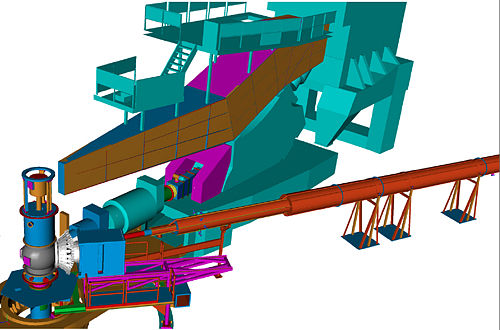Difference between revisions of "DVCS"
| Line 1: | Line 1: | ||
| − | The DVCS2 experiments at Jefferson Lab (LH2: E07-007, [http://hallaweb.jlab.org/experiment/DVCS/documents/phys_prog/E07007_proposal.pdf], LD2: E08-025 [http://hallaweb.jlab.org/collab/PAC/PAC33/PR-08-025:nDVCS.pdf]) will measure the absolute cross sections of electro-production of photons in the deep exclusive regime as part of the GPD program. These experiments build on the success of our first round of data taking ([http://www.slac.stanford.edu/spires/find/hep/www?key=6856306], [http://www.slac.stanford.edu/spires/find/hep/www?irn=7325622]). DVCS measurements at fixed Q<sup>2</sup>, x<sub>Bj</sub> and three different beam energies will be measured. The kinematic structure of the ep→ epγ cross section will allow to separate the different amplitudes contributing to the total cross section (eg. BH*DVCS interference from the pure |DVCS|<sub>2</sub>) term at all three Q<sub>2</sub> values of the previous experiments. Rosenbluth L/T separations of the ep→ | + | The DVCS2 experiments at Jefferson Lab (LH2: E07-007, [http://hallaweb.jlab.org/experiment/DVCS/documents/phys_prog/E07007_proposal.pdf], LD2: E08-025 [http://hallaweb.jlab.org/collab/PAC/PAC33/PR-08-025:nDVCS.pdf]) will measure the absolute cross sections of electro-production of photons in the deep exclusive regime as part of the GPD program. These experiments build on the success of our first round of data taking ([http://www.slac.stanford.edu/spires/find/hep/www?key=6856306], [http://www.slac.stanford.edu/spires/find/hep/www?irn=7325622]). DVCS measurements at fixed Q<sup>2</sup>, x<sub>Bj</sub> and three different beam energies will be measured. The kinematic structure of the ep→ epγ cross section will allow to separate the different amplitudes contributing to the total cross section (eg. BH*DVCS interference from the pure |DVCS|<sub>2</sub>) term at all three Q<sub>2</sub> values of the previous experiments. Rosenbluth L/T separations of the ep→ epπ<sup>0</sup> cross section, which is crucial to testing factorization in this channel will be obtained. A key element of the experiments is the EM calorimeter that is used to detect the photon while the Hall A HRS is used to detect the scattered electron. |
Revision as of 14:55, 29 July 2010
The DVCS2 experiments at Jefferson Lab (LH2: E07-007, [1], LD2: E08-025 [2]) will measure the absolute cross sections of electro-production of photons in the deep exclusive regime as part of the GPD program. These experiments build on the success of our first round of data taking ([3], [4]). DVCS measurements at fixed Q2, xBj and three different beam energies will be measured. The kinematic structure of the ep→ epγ cross section will allow to separate the different amplitudes contributing to the total cross section (eg. BH*DVCS interference from the pure |DVCS|2) term at all three Q2 values of the previous experiments. Rosenbluth L/T separations of the ep→ epπ0 cross section, which is crucial to testing factorization in this channel will be obtained. A key element of the experiments is the EM calorimeter that is used to detect the photon while the Hall A HRS is used to detect the scattered electron.
The upcoming data taking is scheduled from September 27, 2010 to December 28, 2010.
| Contents |
| People |
| DVCS weekly meetings, Summer 2010 |
| DVCS TO DO list, Summer 2010 |
| DVCS how to |
| [The DVCS/Hall A web page] |
| [Global Run Plan] |
| Daily Run Plan |
